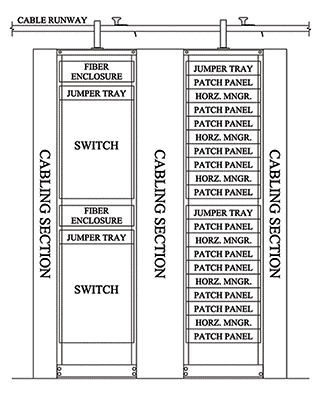
The basic cable management solution features a two-post rack with cabling
sections along both sides of the rack to provide a vertical pathway for premise
cable and patch cords. Cabling sections in-between adjacent racks in a multiple
rack bay must be larger (wider and/or deeper) to support cable from both racks.
Open two-post racks provide the most cost-effective and
efficient use of floor space, but four-post racks are superior when supporting
larger equipment, like modular network switches. Chatsworth Products (CPI) offers three styles of
two-post racks, six styles of four-post racks and five styles of vertical
cabling section in various sizes.
CPI offers five styles of cabling section (vertical
managers) to complement the two-post and four-post open rack systems. Cabling sections
attach to the sides of the racks to provide a cable management space along the
side of rack-mount equipment.
Cabling sections can be single or double-sided. Double-sided
cabling sections are used alongside racks that support patch panels, fiber
enclosures or a mix of active equipment and cable termination hardware to
provide separate front and rear pathways for patch cords and premise cables.
Use cable runway or cable tray to create a pathway for
premise cables through the room. Premise cables typically enter the cabling
sections from overhead cable runway (ladder rack) or cable tray. Be sure to
provide radius drops where cable enters or exits the overhead pathway. Also,
elevate cable runway 3" to 6" (80 mm to 150 mm) above racks to get
the full benefit of the radius drop.
Cable runway or cable tray can be supported from the tops of
racks with elevation kits or from the ceiling with threaded rods. Cable runway
or cable tray can also be divided to allow cable segregation by media or
use/application and tiered to increase capacity.
When selecting a rack solution, it is important to pick a
height that provides enough overhead space for cable runway or cable trays. Always
leave 3” to 6” (80 mm to 150 mm) of space between the top of racks and cable runway.
Leave 12” (300 mm) between each tier of cable runway and 18” (460 mm) between
the ceiling and the top tier of cable runway.
Use jumper trays and horizontal managers on the racks in
between patch panels and network switches (as shown below) to guide patch cords
between connections. Use cable spools inside the cabling sections to control
patch cord slack. Loosely bundle cables with CPI’s Saf-T-Grip® Cable Management
Straps.
Cabling section width and the corresponding
cable fill capacity must be carefully considered, especially when a cabling
section is shared in-between adjacent racks. CPI recommends using a 50 percent cable
fill when selecting vertical and horizontal cable management. This allows
sufficient space for maintaining cable bend radius for patch cords. CPI’s Extended
Fingers (- EFX) versions are recommended whenever angled-face patch panels are
used. Use CPI’s Cable Fill Tool to compare cable fill values and select the
correct size cabling section.
For an informative overview of CPI Cable Management, download this brochure.
Kim Ream, Marketing Project Manager